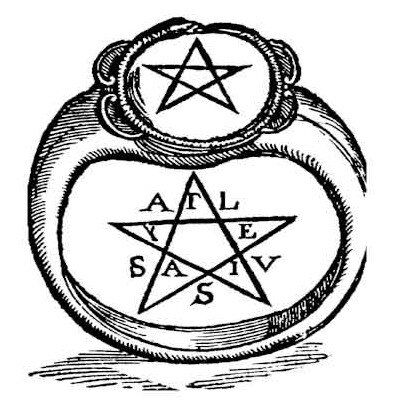Guido von List referred to the pentagram as the "vehme star rose." All of his other signs seemed to be of Germanic or European origin, except that one. Why? It could be that the star was loosely from our ancestors, perhaps even tens of thousands of years ago. It might have been that List couldn't resist the powerful symbol, which easily can be traced back to ancient Sumeria.
More than likely it was because the star was adopted into secret pagan circles in Europe sometime during the middle ages, which makes it "half-folkish" I suppose. A lot of neo-pagans may not want to hear this, but very far back in ancient times, it appears that as the ancestors of Norse, Celtic, and Mediterranean peoples migrated westward, they both drowned out and/or co-opted the various traditions of Sabbat witchcraft. As a result, it's spiritual survival depended upon it's ability to constantly reinvent itself. The "migration" of the vehme star seemed to be a part of that process. A symbol was needed, and with the long eroding disappearance of icons of it's own heritage, one was co-opted.
The symbol found it's way eastward, into the Orient, as well. Curiously, List's term "vehme star" only shows up on six webpages on a google search. It should be noted that the Pythagorean Greeks referred to this symbol as "hugieia" ("health") in the fifth century BC, but it appears that it was more of a symbol of geometry to them. Culturally, it appears, this symbol could be thought of as a symbol of both the West and the Middle East. In other words, the real origin was from a people who later migrated into southern and western Europe and became Indo-Europeans; while those who remained largely merged with dark skinned Semites who dramatically migrated out of the southern Saudi Peninsula northward starting in the sixth century.
 |
What I'm really driving at is that the vehme star rose could be looked at by a Eurofolkish person as being "half folkish." Perhaps even a little bit more than half, since it originated from a people whose racial stock later came to be known as Indo-European. The proto-Norse once occupied northern Eurasia, tens of thousands of years ago. However, nobody today thinks of them as "Asian" in any way. They became Indo-Europeans. In the spiritual tradition of Stregheria in central and southern Italy, during the Middle Ages, the vehme star rose was adopted. It could be said that they adopted a symbol which their remote ancestors had once held sacred. At the least, it's a symbol which has deep roots in Europe.


No comments:
Post a Comment